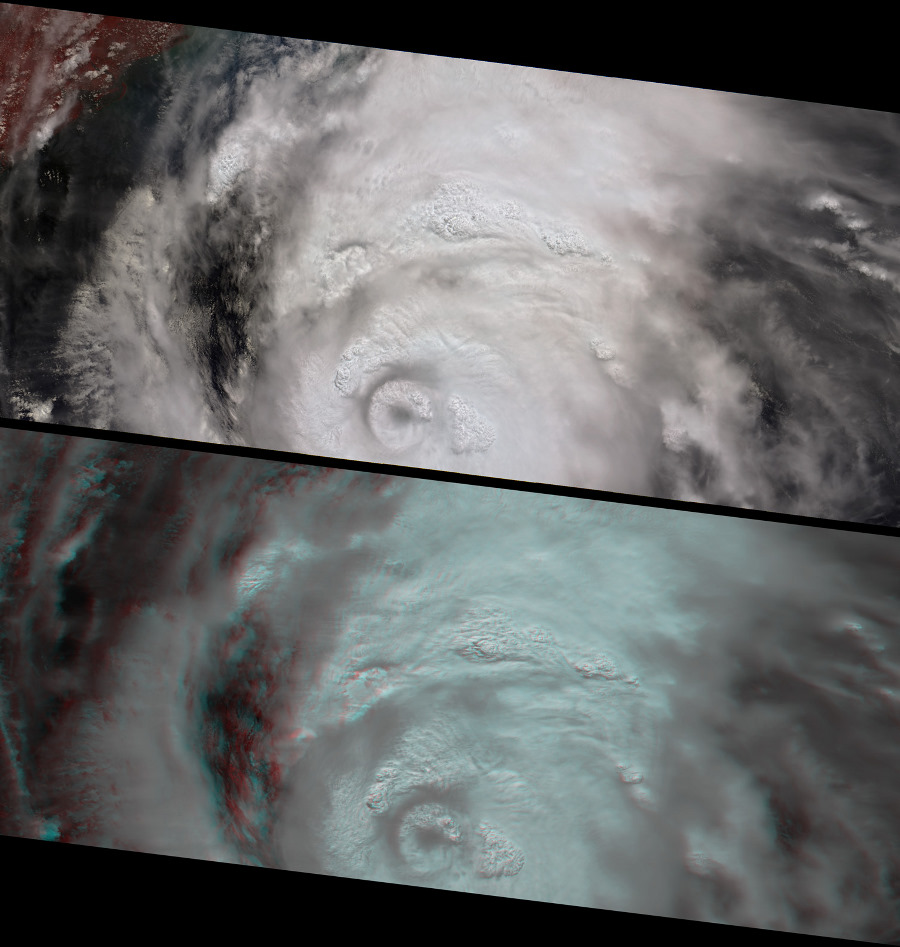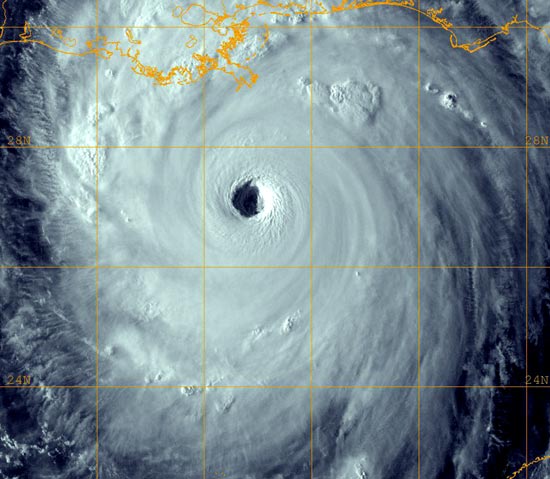|
|
|
|
August 28, 2005
(Click on Image for Full Size) This image and animation from NASA’s Multi-angle Imaging SpectroRadiometer (MISR) show the strong convective development of Hurricane Katrina on Saturday, August 27, as it moved west through the Gulf of Mexico. Over 7 minutes during which all 9 MISR cameras viewed Katrina, the animation captures the cloud-top sides, the counterclockwise rotation of the eyewall, and the bubbling growth of the towering cloud structures. At this time, Katrina was undergoing rapid development— it had just been upgraded to a Category 3 hurricane, and within 24 hours it would reach Category 5. On Monday morning when the eyewall made landfall over the United States, it was a Category 4 storm. Hurricane Katrina was one of the most powerful and destructive storms on record for the Atlantic Basin. The image above is a false-color view (near-infrared, red, and blue wavelengths of reflected light displayed as red, green and blue) from MISR’s nadir (pointing straight down) camera. In the image above, north is up. The high resolution image linked above shows a wider view of this false-color image, with north to the left. The vegetated Alabama coast in the upper left-hand corner in this high resolution image appears in red hues . The bottom panel in the high resolution image is a 3-D stereo anaglyph created with red band data from MISR’s 70-degree-forward-viewing and 60-degree-forward-viewing cameras, displayed as red and green/blue, respectively. To observe the height variations in 3-D, you will need to use red/blue glasses. MISR stereo-height estimates (not shown here) indicate that the highest clouds reach 18- 19 kilometers above the surface of the Earth. The stereo anaglyph shows relative height variations and enhances the appearance of thin clouds, such as those that mark the series of gravity waves north-east of the eyewall. Atmospheric gravity waves are caused by air displacements in an otherwise stable air layer. In this case, the gravity waves are above the hurricane arms in the upper troposphere, and were probably generated as the towering storm updraft tried to push into the stable air between the troposphere and the stratosphere (known as the tropopause). Some of Katrina’s cloud tops were about 2 kilometers above the tropopause. Such high “overshooting tops” are also characteristic of strong and rapidly growing storms. The animation progresses from MISR’s most forward-pointing camera, which views the scene first, to the most backward-pointing camera, which views the scene last. It was created by aligning the views from all 9 cameras using the high clouds within the eyewall as a reference point. North is at the top. The convective cloud towers, especially those along the eastern sides of the inner and outer eyewalls, attain the highest altitudes and indicate that the storm is strengthening. Those areas that do not exhibit cloud-top convection are clouds experiencing vertical wind shear, and tend to be lower than the towering cloud structures. The vertical and horizontal development of the convective clouds and the formation of an outer ring of growing clouds (referred to as an “eyewall replacement cycle”) also indicate rapid strengthening. During this stage of hurricane development, an outer band of clouds may gradually move inward to replace the existing hurricane eyewall, causing the central pressure to increase and weaken the storm in the short term. However, eyewall replacement may sometimes be a forerunner for rapid strengthening in the longer term. This was the case with Hurricane Katrina, whose central pressure increased slightly on Saturday, but then dropped again significantly on Sunday when Katrina became a Category 5 storm. Observing the development of a concentric eyewall at this spatial and temporal resolution is a unique feature of these MISR observations. The Multi-angle Imaging SpectroRadiometer observes the daylit Earth continuously, viewing the entire globe between 82 degrees North and 82 degrees South latitude every nine days. The still images each cover an area of about 827 kilometers by 380 kilometers, and the animation covers an area of about 202 kilometers by 214 kilometers. The data products were generated from a portion of the imagery acquired during Terra orbit 30280 and utilize data from blocks 69 to 74 within World Reference System-2 path 17. MISR was built and is managed by NASA’s Jet Propulsion Laboratory, Pasadena, CA, for NASA’s Science Mission Directorate, Washington, DC. The Terra satellite is managed by NASA’s Goddard Space Flight Center, Greenbelt, MD. JPL is managed for NASA by the California Institute of Technology. Images and movie courtesy of NASA/GSFC/LaRC/JPL, MISR
Team.
|
|
|
|
| FAIR USE NOTICE: This page contains copyrighted material the use of which has not been specifically authorized by the copyright owner. Pegasus Research Consortium distributes this material without profit to those who have expressed a prior interest in receiving the included information for research and educational purposes. We believe this constitutes a fair use of any such copyrighted material as provided for in 17 U.S.C § 107. If you wish to use copyrighted material from this site for purposes of your own that go beyond fair use, you must obtain permission from the copyright owner. | |
|
|


